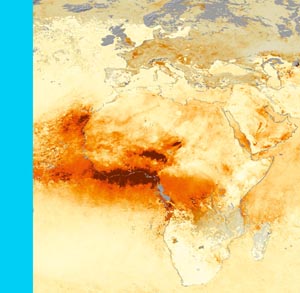Atmosphere

The gaseous component of the Earth system has a total mass of more than 5000 billion tons. Nevertheless the atmosphere (from Greek atmos for vapour) is only a relatively thin layer – all relevant weather phenomena take place in the troposphere, which extends to an altitude of 12 to 15 kilometers only.
Almost nothing has remained from the primary atmosphere that formed together with the Earth some 4500 million years ago. Erosion and, later, life have changed its composition to what we breathe now – a mixture of 78% nitrogen, 21% oxygen and a number of other constituents, among which water vapour and carbon dioxide are most important.
Life on Earth needs the atmosphere not only for breathing. It is an important shield against cosmic radiation, too.
Select your Case Study:
| Trace Gases | |
|---|---|
| Methane, South-East Asia Among other sources, rice cultivation significantly contributes to the concentration of Methane in South-East Asia. |
|
| Ozone Hole, Antarctica The emission of industrially produced chemical components have led to a reduction of stratospheric ozone in the Antarctic region. |
|



